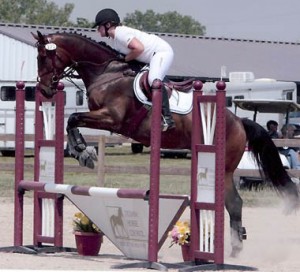In the gritty, dusty corrals where the hard work of retraining ex-racehorse Thoroughbreds is done, lies a groundswell of goodwill uniting professional horseman with a thriving non-profit bent on finding new jobs and good homes for horses retired from the racetrack.
“What started as a trickle, grew to an immense river,” says Kim Smith, a bloodstock agent and horse trainer who, six years ago, founded Thoroughbred re-training organization Second Stride, Inc.
And as the years have passed, and with the assistance of caring owners, trainers and riders the number of horses who have been successfully channeled through the Prospect, KY facility has grown exponentially. Last year alone, 65 Thoroughbreds were re-trained for a variety of disciplines, including dressage, hunter/jumper, and trail riding and also found new owners—all through the generosity of a collection of horse folk with heart.
“When I was a teenager, I had the opinion that people don’t do right by their animals. So my work with Second Stride has opened my eyes, and I now see how much good there is,” Smith says.
“A lot of trainers and owners in the racing industry are caring individuals who really want to do the right thing for their horses. ”
Some owners who donate their racehorses to the program make sizable financial contributions dedicated toward the care and re-training of horses whose destiny is dramatically reshaped. A racing-fit horse may emerge from training as a fat, round and shiny athlete capable of any number of athletic disciplines, Smith explains.
These contributions contribute in a big way to the solvency and stability of the nonprofit, which is also supported through a variety of sponsorships and fundraisers.
But the goodwill flowing from the upper echelons of the industry is also matched in the paddocks of Second Stride; as hardworking exercise riders log extra hours riding the horses they once galloped on the racetrack.
“They know these horses and it’s very comforting, from the horse’s perspective, to see a familiar face,” Smith says. “This way, everything is the same for the horse, it’s just the setting that has changed. It acclimates them to the farm.”
Exercise riders also help figure out a horse’s idiosyncrasies, details that determine what type of rider and next career is most suitable, she adds.
This helps Second Stride avoid the return rate or “bounce” of horses that were purchased with the best intentions, but found to be too difficult or otherwise unacceptable for the new owner, she explains.
Once a horse is brought along by its exercise rider, and deemed acceptable to be ridden by volunteers, more finessing is done before a new rider climbs in the saddle.
All volunteer riders are certified by two trainers, who assess their riding level, before they are allowed to assist in Thoroughbred retraining. And even then, careful consideration is given to determine which horse and rider personalities match before the volunteer rider swings into the saddle.
And once they do, the results have been amazing.
Second Stride has re-trained horses that are now excelling in all manner of new careers. Among the rising star graduates of Second Stride are: Senor Sancho, a three-star cross country competitor who has qualified for the Rolex Three Day; Manchester, who competed in a Beginner Novice event at the 2011 Indiana Eventing Association Horse Trials.
Many, many other graduates are proving themselves in new careers, and helping to disprove the myth that Thoroughbreds who raced are not good for much else, she says.
“Thoroughbreds are very misunderstood,” Smith says, noting the oft-cited criticism that the breed tends to be “hot” and high strung.
“If you go out to any track in the morning you’ll see a horse that will stand there for 15 minutes waiting for their chance to run. They’ll stand there politely while other horses gallop by.”
For over a decade, Erin Buttigieg was among them, barreling down racetracks across the country, exercising promising racehorses.
Now retired from that life, she is one of the exercise riders teaching young Thoroughbreds a new discipline.
“A lot of us think of these horses like we do our kids. We want to see them do really well, and we’ll do anything in our power to make sure they succeed,” Buttigieg says.
“The people who work for Second Stride have the biggest hearts, and when these horses are done with the track, it’s the owners, the volunteers, and people like us who want to make sure these horses will be going to a new home.”






[…] Horsemen help racehorses hit a Second Stride. Fresh from a link on Dale Roman’s Facebook page, finally a use for facebook, here is an article on OTTB and racetrack people who help them too. […]